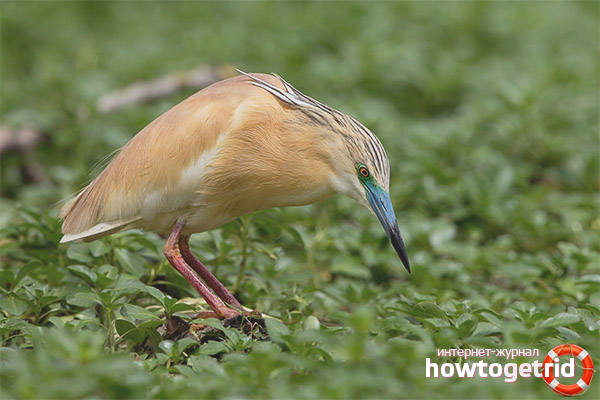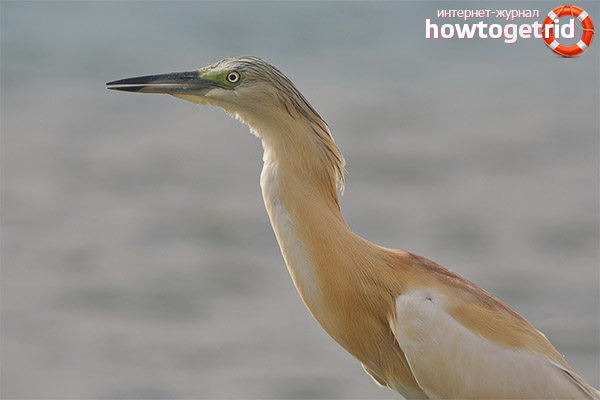The content of the article
The yellow heron can, without a doubt, be distinguished from other representatives of this family in size and compositional features. She is also easily distinguishable by the color of her plumage. But a bird in the air, due to its seemingly white color, can easily be mistaken for one of its relatives. Although on the fly you can still distinguish it, if you look closely at the shape of its wing, which has a large width and an almost even cut in the end.
Appearance
The length of the yellow heron from tail to beak does not exceed 49 centimeters, the weight of an adult reaches 300 grams, in the wingspan it can reach 80 centimeters. This bird is the owner of a light brown plumage, but the color of the belly, like that of other herons, tail and its peculiar wings, have a dirty white hue. The legs of a miniature heron are painted red-brown, its beak is expressed in a rich olive shade, however, the top of the beak is covered in black. During the period when the bird is dressed in a mating outfit, a colorful plumage is formed on its nape, consisting of long feathers, black and white. Young individuals of the yellow heron in their color have brighter colors.
The main habitats of an unusual bird
The yellow heron chooses freshwater areas of marshy lowlands and marshes covered with thickets of reed representatives of the flora as a favorite place for its nesting. In the Asian part of Eurasia, as well as in the Mediterranean, they can be found in abundance. In addition, this bird is also known in the Caucasus, its presence on the African continent is easily confirmed by the inhabitants of Morocco and Ethiopia. It flies here to the open spaces of Africa from the second half of September until the beginning of October, at a time when some individuals prefer wintering in the southern part of the Mediterranean.
When April arrives, it is time to return to the places of their permanent nesting, but the route of individual representatives is arranged somewhat differently, they tend to the coast of the North Sea, according to the command of genetic memory. The presence of the yellow heron in the central part of Europe, everyone can contemplate before the end of the summer period.
This bird, which has completely individual features, is very well known to the inhabitants of Romania, the presence of these birds in the amount of at least 6 thousand pairs was found there, and the inhabitants of Turkey accept these travelers in almost the same quantities. The heron population has recently gained distribution in Armenia.
And in Russia, it is well known in the lower reaches of the valley adjacent to the Lower Don, in the areas of western and eastern Manychy, it is well known to residents of the coastal massifs of Stavropol. But the geographical component of her stay in Russia does not end there. Its presence is known to the few inhabitants living in the floodplains of the Kuban, as well as the Terek, are much less common in the deltas of the Volga and the Urals.
Yellow heron diet
This bird shows the greatest activity in twilight time, twilight hours are the main time of its hunting. She chooses impassable thickets of shrubs or reeds as the venue for her hunt. The subject of her close attention is mainly frogs living in the water or small fish. But with no less appetite, the bird eats various large insects that live in the aquatic environment.
Features of the mating season of the swamp dweller

The yellow heron prefers to settle in colonies and only in rare cases can it settle separately. Most often, she likes to join other herons, for example, loaves or no less famous kolpiks. In such cases, you can see two options for settlement: either a unique representative of her species tries to harmoniously distribute her nests among her closest relatives, or she gets a rebuff and in this case she has to form her own group. Sometimes, in cases of individual settlements, the yellow heron has to arrange its nests on adjacent trees.
The yellow heron in personal relationships chooses a monogamous policy, the partner is selected for the season, and both birds take care of the offspring together. The male is exclusively occupied with the device of the nest; after completing all preparations, he calls the female using his far from melodic voice.
The mating games of these members of the family represent the theater, filled with passions and active actions. The proud male, first of all, shows a complete hostility to his partner, in a fit of indignation, he can even inflict several tangible blows on her. But the tenacity of the female decides everything, which ultimately forces the male to surrender.
Features of the removal of chicks
By the time of laying the masonry, yellow herons do not adhere to a clearly planned schedule. Much depends on the climatic conditions in which the nesting is made. But, besides this, these birds prefer to adapt to the manners of their nearest neighbors, so as not to go against the bulk of the colony, to which they have the habit of attaching themselves.
Both partners are equally preoccupied with hatching masonry; they are alternately on duty at the nest, not for a minute leaving the masonry unattended. After the chicks successfully hatched, the parents also mutually feed the offspring, although the female is the unconditional coordinator in this matter, and the male dutifully serves her.
Young herons become independent on the 45th day of their existence and immediately forget about their parents.
Video: Yellow Heron (Ardeola ralloides)










Submit